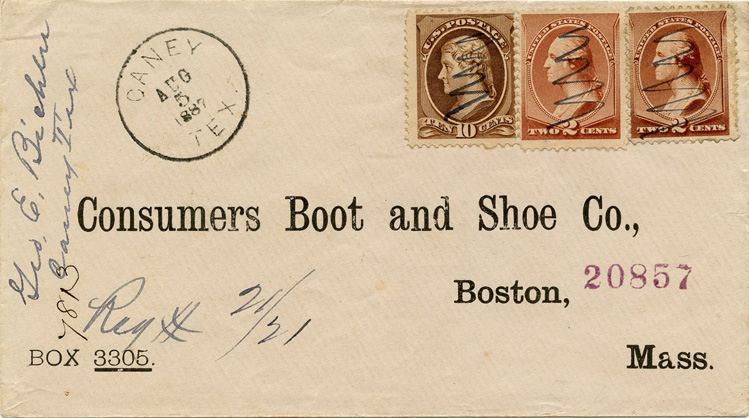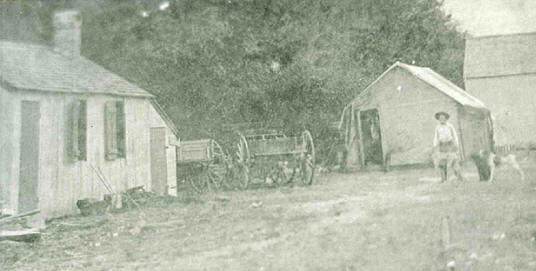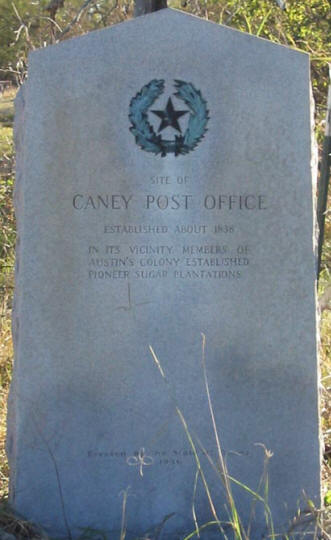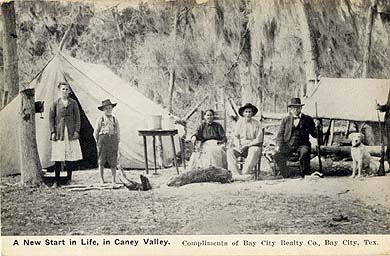|
||
|
||
 Caney August 5, 1887 |
||
|
Mail routes, established by the Republic of Texas in 1838, ran from Matagorda to San Felipe and later to Columbus and used the name Caney Run. The bed of Caney creek was lined with brick in a shallow area so wagons and coaches could cross.
Robert H. Williams had a plantation where the road from Matagorda to Brazoria crossed Caney Creek. He was one of Stephen F. Austin’s “Old 300” and had the first cotton gin in Matagorda County.
The first store at Caney was owned by Presley C. Evans and the post office was in his store building. The store was sold to John Matthews in 1861 and the area began to grow with several businesses. His store was just east of the 1936 Centennial Caney Post Office historical marker.
John Matthews and many members of his family are buried at Caney Cemetery, so it is also known as Caney-Matthews Cemetery. It was the early burial place for Caney settlers and their descendants continue to be buried there.
Mr. Matthews, a ordained Methodist minister, moved from Virginia to Matagorda County. He felt that the community should have a place of worship and built a church adjacent to the cemetery. It is believed that the cemetery had already been established. Travelers passing through the Caney area were invited to worship at the church which was Baptist. Mr. Matthews kept a horse and buggy at the church building for circuit-riding preachers to use to visit the families in the area. In the community, the church building was known as the "Dirty House" because it was never kept clean inside. Mr. Matthews' brother lived in the building after he moved to Caney since the church was used infrequently.
|
||
 The Old Cable Bridge on Caney Courtesy of Matagorda County Museum |
||
|
Situated in the shadows of the Bay City Municipal Airport, near the crossroads of FM 457 and FM 2540 is a small cemetery which was a part of the Caney community, and is now only a memory, except for the historical marker placed on the site during the Texas Centennial in 1936. The marker reads:
Site of Caney Post Office Established about 1838 In its vicinity members of Austin's Colony established pioneer sugar plantations.
During the days of the Republic of Texas--and earlier--the original Caney was once called Caney Crossing. It received its name from Caney Creek, thought to be an old bed of the Colorado River, which flowed through a dense cane brake. Caney Crossing was situated in one of the most historic areas of Matagorda County--the bottom lands of the Colorado River and Caney Creek. This site early acquired the reputation of being the richest in the state, and it was in this area that the largest cotton and sugar plantations were found. At Caney Crossing, where the road from Matagorda to Brazoria crossed Caney Creek, was the plantation of Robert H. Williams who was listed as postmaster as early as September 4, 1838, in the post office records for the Republic. It was mail route "#22 from Brazoria to Matagorda 40 miles via Williams on Caney weekly." In January of 1840, Robert H. Williams received $16.34 for serving as postmaster at Caney Crossing. Travel was uncertain in colonial Texas and was one of the chief causes of the breakdown of the early postal system. In October, 1837, the Matagorda Bulletin protested that "here is one of the principal ports of entry of the country--where in the space of ten days have landed 300 foreigners the county seat of justice- the designated point for locating a land office,--without any communication except in one direction--and that as uncertain as the wind!" Three years later, communication by mail between Matagorda and Brazoria was "very contracted," and as late as the spring of 1844, the Matagorda mail was two months overdue in Houston. Caney Crossing, however, was the best road in the county to travel to get mail from Matagorda to Brazoria and then to Galveston and Houston. Robert H. Williams was not only postmaster but also a prosperous farmer, having the first cotton gin in the county and extensive land holdings. He was one of the "Old 300. ''
In 1846, when Texas became a part of the United States, the postal records listed Thomas Dennis as the postmaster at Caney, a position he held from May 22, 1846, until December 15, 1846, when the post office was discontinued. The post office was reinstated May 4, 1847, with Robert H. Williams as postmaster. Thomas Jamison became postmaster September 29, 1851, followed by Presley C. Evans April 7, 1854.
Presley C. Evans was from Virginia and had come to Texas to establish a store at Caney in 1853. This store was situated toward upper Caney at the crossroads of the routes leading from Matagorda to San Felipe and Columbus and from Brazoria to Texana and Victoria. A ferry some seven miles west across the Colorado River made the road a popular one to carry the harvested crops to market. This new site, approximately two miles from the original Caney Crossing, became known as Caney and survived until 1918.
P C. Evans was postmaster until 1861, when the store passed into the possession of John Matthews, a native of Virginia who had come to Texas in 1857. Under Matthews' leadership and business competence, the area grew In addition to the post office, a general mercantile store, cotton gin, and other businesses sprang up.
Dr. J E. Simons, a pioneer doctor, had his first office in the Matthews store at Caney in 1896. The store became a meeting place of all the residents living near Caney Matthews had been trained as a minister in Virginia but, because of poor health, moved to Texas. With this dedicated religious background, he was instrumental in the establishing of a church in the community in 1863. Construction began in January of that year, and the first service was held June 1st. Ten years later the land for the historic cemetery was given to the community by the Hawkins family.
For more than half a century, John Matthews provided this community with merchandise. Among his customers were E. E. Rugeley, J B. Hawkins, William Warren, Dr Chinn, Mollie Wadsworth, Nellie Wilkerson, Annie Wilkerson, Dr. Thompson, Dr .J. T. Fry, J. L. Croom, Mrs. C. H. Wright, M. Talbot, W. H. Kirkland, J. H. Gibson, A. G. Moore, and Jacob Smith.
Matthews owned and operated the store at Caney until 19l3. The zenith of his merchandising career had been during the reconstruction period following the Civil War. He experienced many trying times and difficulties. Planters, whose plantations were growing up in weeds, made his store a gathering place to air their grievances. His customers were his friends, so he could not turn them down. When they wanted a barrel of flour, some coffee, or perhaps a few pepper grains, they received it. W A. Matthews bought the store from his father’s estate, and operated it until 1918, when it burned.
Julius Glatz served as postmaster from 1866 to 1880 when John Matthews once again assumed the office serving until 1898. William A. Matthews became postmaster in 1898 and served until 1913. Mary L. Bates served for one year. In December, 1914, the Caney postal services were moved to Bay City.
The term Caney now refers to a general area encompassing all of the settlements along Lower Caney Creek from Van Vleck to its mouth.
Historic Matagorda County, Volume I, pages 322-323
|
||
 Caney Store Courtesy of Matagorda County Museum |
||
|
There is an old Indian legend to the effect “long, long ago before the coming of the white man,” in all the country drained by the Brazos and Colorado there was but one river. It was a mighty stream, the Caney (Old Caney). According to the legend the Great Spirit becoming angry with a tribe of Indians who lived in the coast country caused a great storm as punishment. This storm lasted for days and flooded the land. After the storm all was changed. Where had been the great river was now but a small stream. “Caney Creek.” The great river was now two rivers, the white man’s Brazos on the east, the red man’s Colorado on the west. Between the rivers were the hunting grounds of the Karankawas, the gift of the Great Spirit. Taken from Legends of Texas by J. Frank Dobie and published by “The Texas Folklore Society.”
Matagorda County Tribune, Century of Progress Edition, August 26, 1937 |

